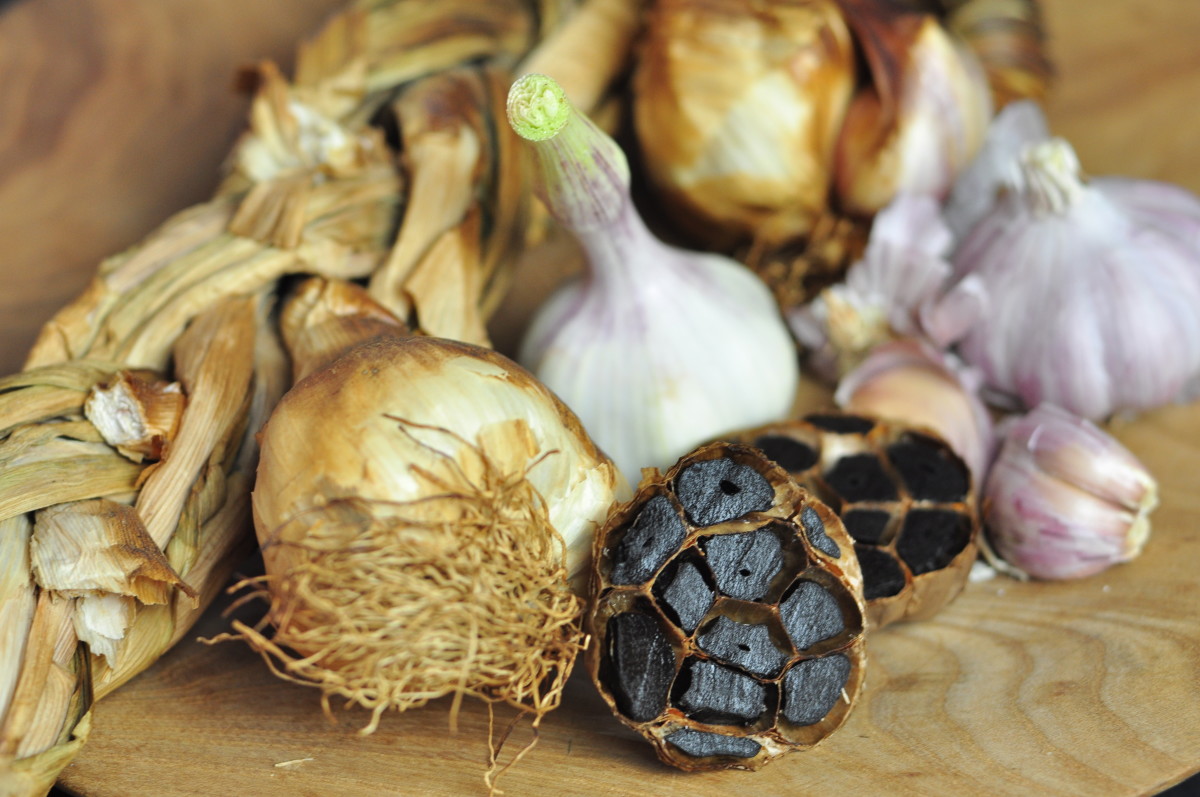Black garlic and caramelized onions both offer a sweet, mellowed-down twist on typically pungent ingredients. But while they share some similarities—like deep color and a rich, savory-sweet flavor—their origins, texture, and best uses vary. Below, we compare black garlic and caramelized onions in flavor, preparation, and practical kitchen applications.
1. How They’re Made
Black Garlic
-
Method: Created by aging fresh garlic in a warm, humid environment (about 60–90 °C) for several weeks. This prolonged process results in the Maillard reaction, darkening cloves to a sticky, jammy consistency.
-
Outcome: Cloves become soft, black, and sweet, with minimal “garlicky” bite.
Caramelized Onions
-
Method: Onions are slowly cooked in oil or butter over low to medium heat, typically for 30–60 minutes. This releases their natural sugars.
-
Outcome: Onions turn golden brown (or deeper) and develop a sweet, slightly savory flavor and tender texture.
Key Difference: Black garlic is transformed through weeks of low-heat aging; caramelized onions come from an hour or so of slow stovetop cooking.
2. Flavor Profiles
Black Garlic
-
Sweetness: Has a candy-like sweetness reminiscent of molasses or dried fruit.
-
Umami Depth: Provides a savory, almost meaty undertone sometimes described as balsamic-like.
-
Mild Aroma: Far less pungent than raw garlic, making it a subtle but complex addition to dishes.
Caramelized Onions
-
Sweet & Slightly Tart: Onions naturally contain sugars that intensify with heat, but still retain a gentle tang.
-
Aromatic: They maintain an oniony essence—pleasantly sweet, but with a hint of sulfur that never fully disappears.
-
Soft Texture: Often described as buttery or jammy once fully caramelized.
Key Difference: While both are sweet and soft, black garlic leans more toward a fruit-like sweetness with a stronger umami punch, while caramelized onions offer a delicate balance of sweet and oniony.
3. Texture Contrasts
Black Garlic
-
Sticky, Chewy: Similar to dried fruit in consistency.
-
Dense Cloves: Each clove is small but concentrated in flavor.
Caramelized Onions
-
Soft, Silky: Onions cook down into ribbons, often used as a spread or mix-in.
-
Moist: Retains some juiciness from the cooking process, especially if not cooked until very dark.
Key Difference: Black garlic is usually served clove by clove or mashed into a paste, while caramelized onions are more ribbon-like and spreadable.
4. Best Culinary Uses
Black Garlic
-
Spreads & Sauces: Blend into compound butters, dressings, or dips.
-
Umami Booster: Stir into soups, marinades, or grain dishes for sweet-savory complexity.
-
Dessert Experiments: Add small amounts to chocolate or caramel-based treats for unexpected depth.
Caramelized Onions
-
Toppings: Slather on burgers, sandwiches, or pizzas.
-
Base for Soups: French onion soup famously relies on deeply caramelized onions.
-
Side Dish: Serve alongside roasts or incorporate into quiches and frittatas.
Key Difference: Black garlic is more versatile in both savory and sweet dishes, whereas caramelized onions primarily shine in savory contexts.
5. Nutritional & Health Notes
Black Garlic
-
Higher Antioxidant Content: Aging may enhance certain antioxidant compounds.
-
Easy Digestion: Less pungent sulfur content can be gentler on the stomach.
-
Moderate Natural Sugars: Cloves are sweet, but typically consumed in small amounts.
Caramelized Onions
-
Low in Calories: Despite sweetness, onions are mostly water and low in overall calories.
-
Potential Loss of Some Nutrients: Long cook times may reduce certain vitamins, though minerals and fiber remain.
-
Sugars Concentrated: Caramelizing does intensify natural sugars, so watch portion sizes if you’re on a strict low-sugar diet.
Key Difference: Both are relatively healthy in moderation, but black garlic may pack a greater antioxidant punch.
6. Pairing Suggestions
Black Garlic
-
Goat Cheese & Creamy Cheeses: Balances tangy flavors.
-
Chocolate, Balsamic, Honey: Amplifies sweet-savory contrast.
-
Grilled Meats, Mushrooms, & Umami-Rich Vegetables: Heightens savory undertones.
Caramelized Onions
-
Sharp Cheeses (Cheddar, Gruyère): Complements sweet onion with salty tang.
-
Roasted Meats & Potatoes: Provides a layered sweetness.
-
Tart Fruits (Cranberries, Apples): Adds brightness and acidity to balance onion sweetness.
Key Difference: Black garlic pairs well with tangy or sweet flavors (and can even tackle dessert territory), while caramelized onions are more straightforwardly suited to savory dishes.
7. Time & Technique
Black Garlic
-
Commitment: Requires up to 6 weeks in a controlled environment.
-
Difficulty: Harder to DIY successfully—specialized gear or store-bought options often yield better results.
Caramelized Onions
-
Quick by Comparison: Usually an hour or less on the stovetop.
-
No Special Equipment: A pan, some oil or butter, and patience are all you need.
Key Difference: Caramelized onions are relatively easy to make at home; black garlic demands more time, care, and sometimes specialized equipment.
Conclusion
While black garlic and caramelized onions both deliver a sweet, softened version of typically pungent ingredients, they’re far from interchangeable. Caramelized onions stay firmly rooted in their onion origin—slightly tangy, aromatic, and best suited for savory mains and sides. Black garlic, by contrast, morphs from pungent raw garlic into a fruit-like, umami-packed ingredient that can hop from savory to sweet recipes with ease.
Whether you’re topping a burger with onions or blending black garlic into a pasta sauce, there’s room for both in the kitchen. Just remember their fundamental differences in flavor, texture, and use—and don’t be afraid to experiment. Happy cooking!

Comments (0)
No comments yet. Be the first to comment!